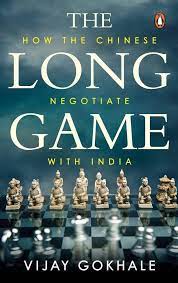Book Summary by Ms. Manasi Pendharkar, Research Intern, PIC
The Long Game: How the Chinese Negotiate with India, by Vijay Gokhale, offers a nuanced exploration of the complex dynamics shaping Sino-Indian relations and delves into the intricate strategies employed by China in its negotiations with India.
The author is former Foreign Secretary of India (2018-2020) and previously served as the Ambassador to China alongside Malaysia and Germany. He is renowned for his expertise in the Indo-Pacific region, particularly in Chinese politics and diplomacy. He has authored insightful books on China, notably, Tiananmen Square: The Making of a Protest (2021), After Tiananmen: The Rise of China (2022), Crosswinds: Nehru, Zhou and the Anglo-American Competition over China (2024).
In this book, Mr. Vijay Gokhale deals with six important events spanning from 1949 to 2019 to illustrate the dynamics of negotiations and India’s evolving approach in dealing with China. He gives a detailed analysis of how these events have shaped the trajectory of Sino-Indian relations. Four events are covered in the book. They are: the recognition of the newly-formed communist government of China in 1949; the diplomatic resolution of the Indochina crisis at the Geneva Conference in 1954; and the two Taiwan Strait crises in 1954-55 and in 1958.
The first chapter, ‘Recognition’, deals with India recognising the People’s Republic of China under the communist regime that overthrew the Nationalist Government under Chiang Kai-shek in October 1949. India’s early decision to extend diplomatic recognition had significant implications, with the Chinese using strategic tactics and planned negotiations to their advantage.
The second chapter, ‘Tibet: The Price of Friendship’, deals with the issue of the Tibetan region, which was the first diplomatic negotiation between the two countries after India recognised the People’s Republic of China (PRC). In this chapter, the author explains how both distraction and deception strategies were used by the Chinese to establish physical and legitimate control (17-Point Agreement) in Tibet. and how it ultimately led to India being entangled in a boundary question deadlock.
The third chapter, ‘Pokhran: How to Untie a Knot from the Tiger’s Neck’, explores India-China relations following India’s nuclear test in May 1998. The author highlights India’s diplomatic triumph amidst Chinese efforts to isolate India internationally and the eventual restoration of ties between the nations by 2001.
The fourth chapter, ‘Sikkim – Half a Linguistic Pirouette’, delves into the intricate diplomatic negotiations which eventually culminated in China’s acknowledgment of Sikkim as a part of India in 2005.
The fifth chapter, ‘123 Deal: The Big Turnout’, looks at the 2008 India-China negotiations regarding the ‘123 Nuclear Deal’, which focused on the efforts of the Chinese counterparts to discourage international exceptions for India.
Chapter six, ‘Masood Azhar: The Principle of Consensus’, examines China’s consistent stance against India’s bid to designate Masood Azhar, the leader of Jaish-e-Mohammed, as a terrorist on the UNSC 1267 Sanctions List. The author gives an account of the diplomatic strategy of China and its impact on India’s efforts to combat terrorism in the light of the strong China-Pakistan alliance.
In the last chapter, ‘Lessons for India’, the author summarises the essence of the book with an elaborate examination of the Chinese negotiating patterns and diplomatic behaviour with India. He offers valuable guidance for future Indian negotiators, while stressing on the need for strategic understanding and caution when dealing with China’s theatrical diplomacy. The author portrays an insightful analysis which highlights the importance of adopting a nuanced approach to negotiations that would pave the way for more effective engagement.
In essence, the book offers a comprehensive and insightful analysis of the intricate dynamics shaping Sino-Indian relations. Through six meticulously researched chapters, the author explores pivotal moments in the diplomatic history between the two nations and provides deep insights into Chinese negotiation tactics and diplomatic strategies. Each chapter presents a compelling narrative, making the book not only a valuable resource for research scholars but also accessible and engaging for those interested in international relations and China. With its clear and concise prose, ‘The Long Game’ attempts to understand the complexities of negotiation and diplomacy in the Indo-Pacific region.
As mentioned in the Preface, “the book explores how China negotiated with India from the early years after Independence until the present, and what lessons India may draw from this about negotiating with the Chinese.”

